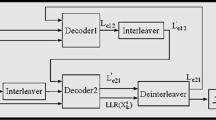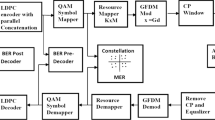Abstract
In this paper, the performance of different type and length interleavers for turbo codes is analyzed in the context of power line communication systems. This system typically operates in very noisy environments; the noise, in this channel, is a combination of colored, narrow band and impulsive noises; it has also strong amplitude attenuations. The digital modulation frequently employed in power line communication to counteract the channel’s noise effects is the orthogonal frequency division multiplexing due to its high spectral efficiency and robustness in multipath fading environments; hence, it is also considered in our experimentation. We report the performance of turbo codes with the two types of interleavers: the high-spread random and the based quadratic permutation polynomial. The constituent codes are part of the 3GPP standard. Finally, it is used a punctured matrix in order to achieve a coding rate of 1/2. The performance is evaluated in terms of bit error rate, through the way of simulations.











Similar content being viewed by others
References
Gotz, M., Rapp, M., Dostert, K.: Power line channel characteristics and their effect on communication system design. IEEE Commun. Mag. 0163–6804 (2004)
Vergara, G.J.: Simulación de un Esquema de Modulación/Demodulación OFDM Utilizando un Modelo de Canal Multitrayectoria. Tesis de grado, Facultad de Ingeniería en Electricidad y Computación, Escuela Superior Politécnica del Litoral. Guayaquil–Ecuador (2008)
Berrou, C., Glavieux, A., Thitimaishida, P.: Near Shannon limit error-correcting coding and decoding: Turbo codes. In: Proceedings of IEEE International Conference on Communications, vol. 2, pp. 1064–1070. Geneva (1993)
Lazcano-Salas, S., Garcia-Ugalde, F.: An improved methodology to design rate compatible punctured turbo codes. Signal Image Video Process. 4(4), 405–408 (2010). doi:10.1007/s11760-009-0130-7
Crozier, S.: New high-spread high-distance interleavers for turbo-codes. In: 20th Biennial Symposium on Communications, Queen’s University, Kingston, Canada, May 28–31, 2000
Rosnes, E.: On the minimum distance of turbo codes with quadratic permutation polynomial interleavers. IEEE Trans. Inf. Theory 58(7), 4781–4795 (2012)
Babic, M., Bausch, J., Kistner, T., Dostert, K.: Performance analysis of coded OFDM systems at statistically representative PLC channels. In: Power Line Communications and Its Applications, 2006 IEEE International Symposium on, pp. 104–109 (2006)
Zimmermann, M., Dostert, K.: A multipath model for the powerline channel. IEEE Trans. Commun. 50, 553–559 (2002)
Mlynek, P., Koutny, M., Misurec, J.: Multipath channel model of power line. Elektroreview 1(2), 48–53 (2010). ISSN 1213–1539
Jung, S.: A channel model for powerline communications in home network. In: Proceedings on the 15th CISL Winter Workshop, Kushu, Japan, February (2002)
Banwell, T.C., Galli, S.: A novel approach to the modeling of the indoor power line channel part I: circuit analysis and companion model. IEEE Trans. Power Deliv. 20(2), 655–666 (2005)
Wei, X., Liu, J., Li, Y.: Simulation and analysis of power transmission line model. In: IEEE International Symposium on Power Line Communications and Its Applications ISPLC ’06, pp. 256–260 (2006)
Mandelbaum, D.M.: An adaptive feed-back coding using incremental redundancy. IEEE Trans. Inf. Theory IT-20, 388–389 (1974)
Hagenauer, J.: Rate-compatible punctured convolutional codes (RCPC codes) and their applications. IEEE Trans. Commun. 36, 389–400 (1988)
Lugand, L.R., Costello Jr, D.J., Deng, R.H.: Parity retransmission hybrid ARQ using rate 1/2 convolutional codes on a nonstationary channel. IEEE Trans. Commun. 37, 755–765 (1989)
Sklar, B.: Digital Communication Fundamentals and Applications, 2nd edn, pp. 477–511. Prentice Hall, Upper Saddle River, NJ, 07458
Dolinar, S., Divsalar, D.: Weight Distribution for Turbo codes Using Random and Nonrandom Permutations. JPL Progress report 42–122, pp. 56–65, August 15 (1995)
Crozier, S., Lodge, J., Guinand, P., Hunt, A.: Performance of turbo codes with relative prime and golden interleaving strategies. In: Sixth International Mobile Satellite Conference (IMSC’99), pp. 268–275. Ottawa, Canada, June 16–18 (1999)
Sun, J., Takeshita, O.Y.: Interleavers for turbo codes using permutation polynomials over integer rings. IEEE Trans. Inf. Theory 51(1), 101–119 (2005)
Ryu, J., Takeshita, O.Y.: On quadratic inverses for quadratic permutation polynomials over integer rings. IEEE Trans. Inf. Theory 52(3), 1254–1260 (2006)
Takeshita, O.Y.: Permutation polynomial interleavers: an algebraic-geometric perspective. IEEE Trans. Inform. Theory (2006). Submitted for publication [Online]. Available: http://arxiv.org/abs/cs.IT/0601048/
3GPP Technical Specification Group: Multiplexing and Channel Coding (TDD), TS 125.212 V6.7.0. December 2005
Babich, F., Montorsi, G., Vatta, F.: Some notes on rate-compatible punctured turbo codes (RCPTC) design. IEEE Trans. Commun. 52(5), 681–684 (2004)
Garello, R., Pierleoni, P., Benedetto, S.: Computing the free distance of turbo codes and serially concatenated codes with interleavers: algorithms and applications. IEEE J. Select. Areas Commun. 19(5), 800–812 (2001)
Acknowledgments
We thank the program of Doctoral Scholarships CEP in the UNAM in Mexico, and DGAPA-UNAM project PAPIIT IN-112513.
Author information
Authors and Affiliations
Corresponding author
Rights and permissions
About this article
Cite this article
Balbuena-Campuzano, C.A., García-Ugalde, F.J. Performance of HSR and QPP-based interleavers for turbo coding on power line communication systems. SIViP 8, 615–624 (2014). https://doi.org/10.1007/s11760-013-0567-6
Received:
Revised:
Accepted:
Published:
Issue Date:
DOI: https://doi.org/10.1007/s11760-013-0567-6




